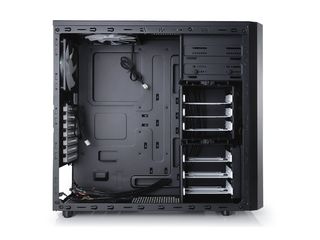TechRadar Verdict
Pros
- +
Price
- +
Good attention to detail
- +
Cooling options
- +
Removable HDD cage
Cons
- -
No USB 3.0 ports
- -
Cable management could be better
Why you can trust TechRadar
We checked out Fractal Design's Define Mini a couple of months back, and now we have another of its minimalist designs sitting on the test bench. The Core 3000 is the first in a new range of budget cases from the award-winning Swedish manufacturer.
This series of chassis have been designed to offer Fractal Design's usual design features, cooling performance and build quality, but at a lower price point than its other enclosure line-ups.
Like most of Fractal Design's cases, the Core 3000 doesn't shout about its presence. Its clean, almost basic looking design is easily overlooked as just another standard, boring box. That's until you look at the rear of the case, where the sober black finish is broken by the white expansion plates and blades of the rear fan.
Once you open it up and get inside, the build quality, design features and attention to detail prove that this no basic budget case.
Value added

Despite carrying that value tag, the Core 3000 still retains many of the usual Fractal Design features. Most obviously the tool-free design, removable drive cages and plenty of cooling fan mounts. The cable management isn't as good as that of the Define Mini or any other of the more expensive cases.
For storage purposes there are two 5.25-inch drive bays and six 3.5-inch bays, with the latter being split between two drive cages. The top cage is removable, which is handy because it allows you to use longer graphics cards in your system – we're looking at you AMD. The trays don't need any tools to secure them into the case, but you do have to use screws to attach any drive to the tray. Said trays not only come with rubber mounts to cut down on noise from mechanical drive vibration, they're also pre-drilled to support 2.5-inch SSDs.
There are plenty of cooling options too. The case comes with three fans already fitted (along with a fan controller), two 140mm (one in the roof of the case, the other behind the front bezel) and a 120mm unit fitted to the rear panel. There are also mounts for four more, two of which (side panel and roof) can be fitted with either 120 or 140mm fans. The remaining two mounts are 120mm only and are to be found behind the front bezel and in the floor of the case.
The top I/O panel includes four USB 2.0 and two audio ports, but sadly it lacks eSATA support and USB 3.0 ports. Although Fractal has pinned a 'value' tag on the Core 3000, for the most part you would never guess. It has the build quality we've come to expect, and the attention to detail is first rate for the most part.
There are a couple of areas where Fractal has been forced to make compromises to keep the price down. There are no USB 3.0 ports and the cable management, which is a high point of the other cases in Fractal's product line, is poorly implemented here.
That said, it still has the build quality that's become the hallmark of Fractal Design chassis, and for the most part you'd hardly know it was a budget model.
Follow TechRadar Reviews on Twitter: http://twitter.com/techradarreview

Researchers produce thinnest sheet of metal ever using a 100-year old Japanese technique — Goldene could pave way for super catalysts, ultra high density optical storage and much more

Thomas & Uber Cup live stream 2024: how to watch badminton FREE online

A mystery Wear OS watch has just surfaced as the Pixel Watch 3 gets closer
